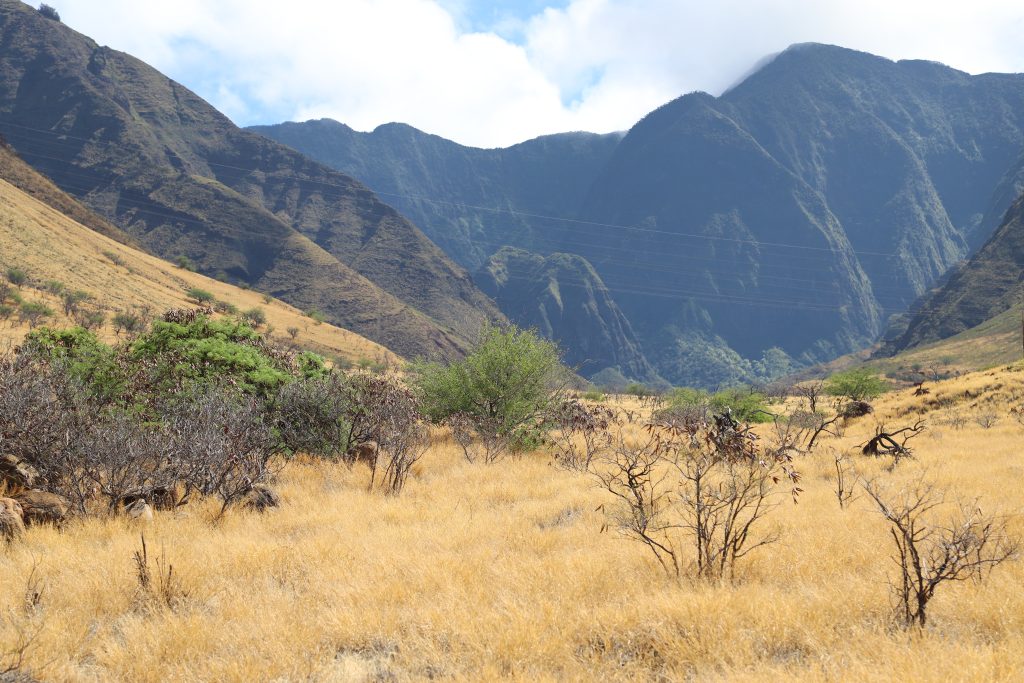7/19/24 – $10 MILLION NOAA GRANT FOR SUMMIT-TO-SEA PROJECT TO PROTECT MAUI REEF
Posted on Jul 19, 2024 in Aquatic Resources, Forestry & Wildlife, Main, News Releases, slider| JOSH GREEN, M.D. GOVERNOR |
DAWN CHANG
CHAIRPERSON |
FOR IMMEDIATE RELEASE
July 19, 2024
$10 MILLION NOAA GRANT FOR SUMMIT-TO-SEA PROJECT TO PROTECT MAUI REEF
(KAHULUI, MAUI) – A nearly $10 million-dollar ($9,909,551) grant has been recommended for funding by National Oceanic and Atmospheric Administration (NOAA) Office of Habitat Conservation, through the Bipartisan Infrastructure Law and Inflation Reduction Act.
Mauka to makai, ridge to reef, summit to the sea, all mean the same thing to Hawai‘i land and ocean managers and conservationists. They’re holistic approaches to addressing ecological issues from mountain forests down to coastal coral reef ecosystems.
The Transformational Habitat Restoration and Coastal Resilience Grant will be used to support a comprehensive approach to restoring and protecting West Maui reefs, particularly the 1,000-acre leeward Pāpalaua Beach Park to Olowalu reef. It is considered globally significant and plays a vital role in coastal resilience, in reducing shoreline wave energy, and moderating coastal flooding.
The DLNR Division of Forestry and Wildlife (DOFAW) will lead the three-year grant, working in collaboration with the Division of Aquatic Resources (DAR) and a half dozen conservation organizations to carry out an entire suite of actions. NOAA’s Office of Habitat Conservation recommended the grant for funding through its Transformational Habitat Restoration and Coastal Resilience grant program, which is funded through the Bipartisan Infrastructure Law and Inflation Reduction Act.
DLNR Chair Dawn Chang said, “This transformational grant is a real game changer. While the Olowalu reef system on Maui will benefit from this holistic, summit-to-sea approach to land and ocean management, there are many other impacted regions across the state that will benefit from the best practices and lessons learned during this project. We appreciate the support from NOAA and the Hawai‘i congressional delegation and applaud their commitment and recognition that coral reefs are the very foundation of life in the islands and deserve the highest degree of protections possible.”
DOFAW Maui Branch Manager Scott Fretz said, “The project area is Olowalu to Ukumehame. This is an area where we have effective land management in the upper elevations of state forest reserves. However, one of the real challenges resource managers have faced for many years in the project area, is that lower elevation lands have a number of issues that lead to erosion and sedimentation that impacts the coral reef ecosystem.”
Years ago, DOFAW was approached by some of its marine partners to talk about a collaboration to address the problems the Olowalu reef is experiencing. “So, this brings that management together, from the summit to the sea; our watershed management at the top of the mountain all the way down to the management of the reef,” Fretz explained.
The integrated approach, provided by the NOAA grant, has five major objectives.
- Control feral ungulates by constructing a contiguous set of fences to serve as barriers to pigs, goats, and axis deer, and remove all feral ungulates from the area.
- Reduce the frequency and intensity of wildfires by constructing new and maintaining existing firebreaks to reduce habitat loss and erosion.
- Stabilize soils by reforesting and replanting to restore resilient, native habitats.
- Restoration of wetlands and riparian habitats.
- Preventing sediment from entering the ocean by building a sediment capture basin and plan for restoration of a historic wetland in the area.
- Engage communities by incorporating native Hawaiian traditional and cultural knowledge into planning and actions to enhance the resilience of the Olowalu reef and coastal communities.
DOFAW Administrator Dave Smith noted, “Fire is a major cause of sediment ending up on the reef. We have grass fire cycles that create bare soil, making it vulnerable to erosion. Stopping wildfires is important. That means fire breaks, fuels management, and green breaks. We are looking at putting in two, 40,000-gallon dip tanks that helicopters can draw from during active fires.”
That’s one part of the holistic approach which also includes:
- Construction and/or maintenance of 10 miles of ungulate fencing.
- Construction and maintenance of 20 miles of fire breaks.
- Construction and maintenance of a 3,500-foot riparian corridor in Olowalu Valley.
- Establish five, 50-acre restoration sites and introduce 30,000 plants to each, annually.
- Complete plans, design, and construction of a sediment detention basis at Manawaipueo.
Fretz says he’s certain all the projects will be completed during the grant window. “Absolutely, 100 percent. We’ve got great marine and community partners. We talked to a lot of folks when we wrote this grant and really thought it through. We look forward to working with NOAA on the next steps in the process.”
He added that this is a good model for other impacted areas, by showing how implementation of a full suite of actions can measurably stop sediment from reaching the ocean.
NOAA’s Transformational Habitat Restoration and Coastal Resilience Grants total $220 million and will fund 32 new programs nationwide.
# # #
RESOURCES
(All images and video courtesy: DLNR)
HD video – Summit to Sea Restoration of a Vital Hawai’i Reef (July 22, 2024):
HD video – Olowalu Resilient Reef project area (various dates):
HD video – Olowalu Resilient Reef project area high-altitude aerials (July 18, 2024):
HD video – Olowalu Resilient Reef project SOTS (July 15, 2024):
Photographs – Olowalu Resilient Reef project area high-altitude aerials and project area (July 16, 2024 and July 19, 2024):
Media Contact:
Dan Dennison
Communications Director

